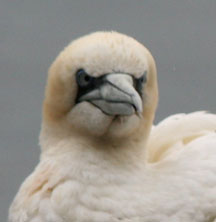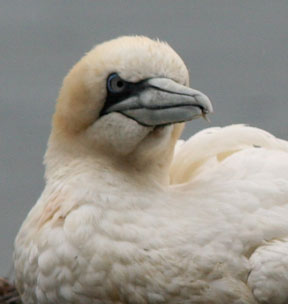Northern Gannet Rescued from Chebeague and at the Avian Haven
 9/9/12 - message from Dianne: Beverly, I am very sad to tell you that the gannet died last night. We thought he had been doing better; yesterday he was awake almost all day and even did a little swimming in one of the pools. The plan was for our veterinarian to start the beak repair tomorrow. But it wasn’t to be.
9/9/12 - message from Dianne: Beverly, I am very sad to tell you that the gannet died last night. We thought he had been doing better; yesterday he was awake almost all day and even did a little swimming in one of the pools. The plan was for our veterinarian to start the beak repair tomorrow. But it wasn’t to be.
Marc did a necropsy this afternoon and found what looked like extensive fungal plaques in the respiratory tract. It was a fairly advanced condition that had been going on for some time. Perhaps that was what weakened the bird to a point where he made the mistake that led to his beak injury – or (I seem to remember you wondering if this could be the same bird that had been seen beached previously) perhaps the beak injury came first, and his inability to feed himself weakened him to a point where a fungal infestation got the upper hand. Aspergillosis is not uncommon in birds, especially aquatic species, and especially this time of year.
All that said – we really appreciate your heroic rescue, which gave the bird a chance for help. We can’t save them all, but I’m sure you’d agree that it’s the given chance that’s important.
9/5/12 Update 8:29pm from Dianne: Hi Beverly. Sorry for the delay in further news; it’s been very busy here.
The gannet seems to be slowly getting stronger; this evening for the first time he took fish from forceps. We are concentrating now on building him up from a starvation state. He spends 95% of the time sleeping, during daylight hours in a lukewarm indoor pool, and at night on a heated foam pad (dry-docked). Meanwhile we have consulted with a wildlife veterinarian with expertise in seabird medicine; she’s given us some ideas for beak repair, which we will begin to implement once he starts to gain weight. Keep your fingers crossed! I should be able to get you some photos by the end of the week.
9/3/12 - Update 4:20 pm from Dianne: We took a closer look at the beak this morning; it's pretty bad, though we do have some thoughts on how to try a repair, and will certainly consult with wildlife veterinarians with expertise in this area. However a more immediate concern is that the bird is extremely lethargic, and remains in the species' characteristic sleeping pose unless roused. Basic blood work revealed parameters indicative of a severely debilitated state. We want to get the bird stabilized before even thinking about beak repair, and also want to take another x-ray, probably tomorrow, to get a better look at some subtle densities on one side of the chest. Meanwhile we are continuing with supportive care, which included feeding the bird a meal of Atlantic capelin. Photo below taken by Glori Berry at the Haven.

9/2/12 - A Northern Gannet that was not well and hanging out on the ledges in front of Brian Layng's house. Brian talked with Stephen and we took photos and I called Stella Walsh who gave me the number for Avian Haven. Dianne from Avian Haven talked to us on how safely to capture one of the largest seabirds of North Atlantic and how dangerous it could be for the us. We got a large heavy blanket and a lobster crate. Stephen decided we should use the punt in case the gannet went for the water and we grabbed John Martin from his daily bike ride to help us. The bird was quietly sitting on the top of the ledge when Stephen and I holding the blanket open tried to throw it over the bird to control it but he escaped I think three times but I was too excited to be counting. He took for the water as Stephen had suspected he would and so we all jumped into the outboard again. We got beside him and I don't know quite how Stephen did it but he picked him out of the water and John opened the crate - too bad the camera's weren't rolling. I will have to find out from Brian what the scene looked like as he saw us from above.
Dianne arranged for volunteers Kathy Stager and her husband from North Yarmouth to pick him up at Cousins and bring him to Gardiner.
Email report as of 8pm from Avian Haven: The gannet arrived safely and has no apparent injuries other than a badly split lower beak, which would have left him unable to feed normally. X-ray looks okay; we didn't take blood yet, but will tomorrow. He's thin and lethargic. He's had some electrolyte fluids and is sound asleep on a heated foam pad. Tomorrow we'll do some more diagnostics and think about how we might repair that beak.
To be continued tomorrow,
Diane
Facts about Northern Gannets from All About Birds: "Breeding in only a few large colonies along the North Atlantic, the Northern Gannet spends most of its life at sea. Flocks engage in spectacular bouts of plunge-diving for fish, with hundreds of birds diving into the ocean from heights of up to 40 meters (130 feet)."
another resource: http://www.neseabirds.com/Birdsgannet.htm



 9/9/12 - message from Dianne: Beverly, I am very sad to tell you that the gannet died last night. We thought he had been doing better; yesterday he was awake almost all day and even did a little swimming in one of the pools. The plan was for our veterinarian to start the beak repair tomorrow. But it wasn’t to be.
9/9/12 - message from Dianne: Beverly, I am very sad to tell you that the gannet died last night. We thought he had been doing better; yesterday he was awake almost all day and even did a little swimming in one of the pools. The plan was for our veterinarian to start the beak repair tomorrow. But it wasn’t to be.


